Related Research Articles
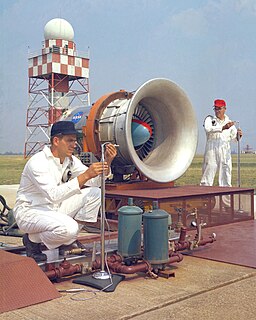
Noise is unwanted sound considered unpleasant, loud or disruptive to hearing. From a physics standpoint, there is no distinction between noise and desired sound, as both are vibrations through a medium, such as air or water. The difference arises when the brain receives and perceives a sound.
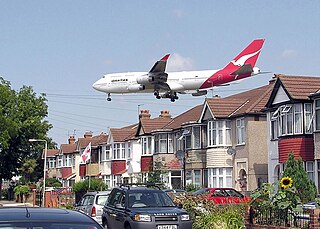
Noise pollution, also known as environmental noise or sound pollution, is the propagation of noise with ranging impacts on the activity of human or animal life, most of them harmful to a degree. The source of outdoor noise worldwide is mainly caused by machines, transport, and propagation systems. Poor urban planning may give rise to noise disintegration or pollution, side-by-side industrial and residential buildings can result in noise pollution in the residential areas. Some of the main sources of noise in residential areas include loud music, transportation, lawn care maintenance, construction, electrical generators, wind turbines, explosions, and people.
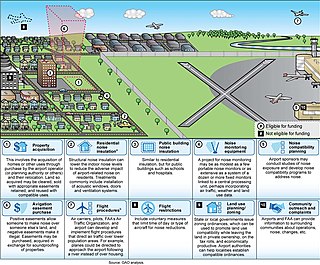
Environmental noise is an accumulation of noise pollution that occurs outside. This noise can be caused by transport, industrial, and recreational activities.
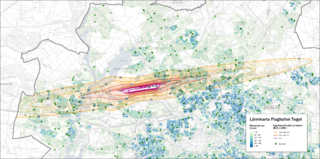
Aircraft noise pollution refers to noise produced by aircraft in flight that has been associated with several negative stress-mediated health effects, from sleep disorders to cardiovascular ones. Governments have enacted extensive controls that apply to aircraft designers, manufacturers, and operators, resulting in improved procedures and cuts in pollution.

Reno–Tahoe International Airport is a public and military airport three miles (4.8 km) southeast of downtown Reno, in Washoe County, Nevada, United States. It is the state's second busiest commercial airport after Harry Reid International Airport in Las Vegas. The Nevada Air National Guard has the 152nd Airlift Wing southwest of the airport's main terminal. The airport is named after both the City of Reno, Nevada and Lake Tahoe. The airspace of Reno-Tahoe Airport is controlled by the Northern California TRACON and Oakland Air Route Traffic Control Center.

Visalia Municipal Airport is five miles west of downtown Visalia, in Tulare County, California, United States. The airport is eligible for the Essential Air Service program, but has no scheduled air service, and is not eligible to request funding for service until April 30, 2026.
Falls International Airport is a city-owned public-use airport located in International Falls, a city in Koochiching County, Minnesota, United States. It is mostly used for general aviation but is also served by one commercial airline with scheduled passenger service subsidized by the Essential Air Service program.
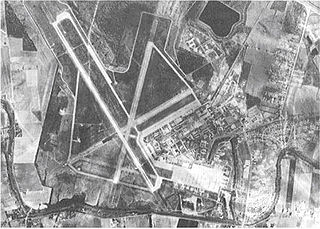
Alexandria International Airport is a public use airport located four nautical miles west of the central business district of Alexandria, in Rapides Parish, Louisiana, United States. The airport is operated by the England Authority, also known as the England Economic and Industrial Development District, an independent political subdivision of the State of Louisiana. Although international commercial flight operations are not conducted, charter flights for the U.S. military to international destinations are routinely conducted from the airfield with this activity including the transportation of U.S. troops to overseas locations.

Delta County Airport is a county-owned public-use airport located two nautical miles southwest of the central business district of Escanaba, a city in Delta County, Michigan, United States. It offers limited commercial service, which is subsidized by the Essential Air Service program.

Oakland County International Airport is a county-owned public-use airport located in Waterford Township, Oakland County, Michigan, United States. The airport is located approximately one mile from the center of Waterford Township and Oakland County. It is included in the Federal Aviation Administration (FAA) National Plan of Integrated Airport Systems for 2017–2021, in which it is categorized as a non primary commercial service facility.
In acoustics, noise measurement can be for the purpose of measuring environmental noise or measuring noise in the workplace. Applications include monitoring of construction sites, aircraft noise, road traffic noise, entertainment venues and neighborhood noise. One of the definitions of noise covers all "unwanted sounds". When sound levels reach a high enough intensity, the sound, whether it is wanted or unwanted, may be damaging to hearing. Environmental noise monitoring is the measurement of noise in an outdoor environment caused by transport, industry and recreational activities. The laws and limits governing environmental noise monitoring differ from country to country.

Noise control or noise mitigation is a set of strategies to reduce noise pollution or to reduce the impact of that noise, whether outdoors or indoors.

A sound level meter is used for acoustic measurements. It is commonly a hand-held instrument with a microphone. The best type of microphone for sound level meters is the condenser microphone, which combines precision with stability and reliability. The diaphragm of the microphone responds to changes in air pressure caused by sound waves. That is why the instrument is sometimes referred to as a sound pressure level meter (SPL). This movement of the diaphragm, i.e. the sound pressure deviation, is converted into an electrical signal. While describing sound in terms of sound pressure metrics, such as Pascals, is possible a logarithmic conversion is usually applied and the sound pressure level is stated instead, with 0 dB SPL equal to 20 micropascals.
Noise regulation includes statutes or guidelines relating to sound transmission established by national, state or provincial and municipal levels of government. After the watershed passage of the United States Noise Control Act of 1972, other local and state governments passed further regulations.

Hearing conservation programs are designed to prevent hearing loss due to noise. Hearing conservation programs require knowledge about risk factors such as noise and ototoxicity, hearing, hearing loss, protective measures to prevent hearing loss at home, in school, at work, in the military and, and at social/recreational events, and legislative requirements. Regarding occupational exposures to noise, a hearing conservation program is required by the Occupational Safety and Health Administration (OSHA) "whenever employee noise exposures equal or exceed an 8-hour time-weighted average sound level (TWA) of 85 decibels (dB) measured on the A scale or, equivalently, a dose of fifty percent." This 8-hour time-weighted average is known as an exposure action value. While the Mine Safety and Health Administration (MSHA) also requires a hearing conservation program, MSHA does not require a written hearing conservation program. MSHA's hearing conservation program requirement can be found in 30 CFR § 62.150, and is very similar to the OSHA hearing conservation program requirements. Therefore, only the OSHA standard 29 CFR 1910.95 will be discussed in detail.
The Next Generation Air Transportation System (NextGen) is an ongoing modernization project of the United States National Airspace System (NAS). The U.S. Federal Aviation Administration (FAA) began work on NextGen improvements in 2007 and plans to have all major components in place by 2025.

A noise dosimeter or noise dosemeter is a specialized sound level meter intended specifically to measure the noise exposure of a person integrated over a period of time; usually to comply with Health and Safety regulations such as the Occupational Safety and Health (OSHA) 29 CFR 1910.95 Occupational Noise Exposure Standard or EU Directive 2003/10/EC.

Daniel Field is a public use airport located one nautical mile (2 km) west of the central business district of Augusta, a city in Richmond County, Georgia, United States. It is owned by the City of Augusta and operated by the General Aviation Commission. This airport is included in the National Plan of Integrated Airport Systems for 2021–2025, which categorized it as a general aviation facility.
Sound annoyance is "a feeling of displeasure associated with any agent or condition [related to sound] that is believed to affect adversely an individual or a group".
Effective perceived noise in decibels (EPNdB) is a measure of the relative noisiness of an individual aircraft pass-by event. It is used for aircraft noise certification and applies to an individual aircraft, not the noise exposure from an airport. Separate ratings are stated for takeoff, overflight and landing events, and represent the integrated power sum of noisiness during the event. Instantaneous value of noisiness is computed with the PNL or PNdB metric over the period within which the noise from the aircraft is within 10 dB of the maximum noise It is defined in Annex 16 of the Convention on International Civil Aviation and in Part 36 of the US Federal Aviation Regulations. The scaling is such that the EPNdB rating represents the integrated noisiness over a ten-second period; EPNdB of 100 dB means that the event has the same integrated noisiness as a 100 PNdB sound lasting ten seconds. Direct comparison with A-weighted sound pressure level, which is used for many other environmental sound measurements, is not possible because PNdB is a noisiness metric rather than a sound pressure metric.
References
- ↑ Airport Noise Compatibility Planning (14 CFR Part 150). October 19, 2018. Federal Aviation Administration.
- ↑ "Noise Monitoring". Massport. Archived from the original on 1 February 2014. Retrieved 31 January 2014.